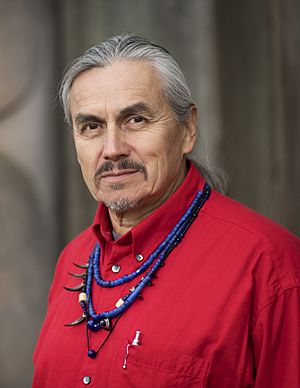Jim Hart (artist) facts for kids
Quick facts for kids
|
|
|---|---|

Hart in 2017
|
|
| Born | 1952 |
| Nationality | Canadian Haida |
| Occupation | Hereditary Chief of Haida Carver |
| Known for | Working in bronze and wood |
|
Notable work
|
Reconciliation Pole – UBC, 2017 Frog Constellation – SFU, 1995 |
| Awards | Officer of the Order of Canada (2023) Order of British Columbia (2003) |
James Hart (also known as 7IDANsuu, pronounced ee-dan-soo) is a famous Canadian and Haida artist. He is also a chief of the Haida Nation. He was born in the early 1950s.
Contents
Jim Hart's Life Story
Hart was born in Masset, a town on Haida Gwaii in British Columbia. His mother, Joan Hart, was the granddaughter of the well-known artist Charles Edenshaw.
Because his father was European, Jim did not have to go to the Canadian Indian residential school system. Many Haida children were forced to attend these schools. Instead, he grew up with his grandparents and learned to be a fisherman.
Becoming an Artist
Jim Hart discovered his love for Haida art when he was in high school. He started carving seriously in 1979.
In 1978, he began working with Robert Davidson. They built totem poles together. From 1980 to 1984, he became an assistant to Bill Reid in Vancouver. Bill Reid was a famous artist, but he was very sick with Parkinson's disease. This made it hard for him to carve much on his own.
Jim Hart helped Bill Reid finish important artworks. He added the final details to The Raven and the First Man. This large sculpture is a main piece at the Museum of Anthropology at UBC. He also helped with Spirit of Haida Gwaii / The Jade Canoe.
A Hereditary Chief
Jim Hart lives in both Vancouver and Haida Gwaii. In Haida Gwaii, he is known as ˀIdansuu. This is a special hereditary chief name. He received this name in 1999. Charles Edenshaw, his great-grandfather, had held this name before him.
As a chief, Jim Hart is part of the Hereditary Chiefs Council. This council helps lead the Haida Nation.
Jim Hart's Artworks
Jim Hart was the first artist from the Northwest Coast to use bronze. He started working with bronze in 1982. He has also created beautiful pieces using silver and gold.
In 1988, he led the building of a traditional Haida house. This house is now at the Canadian Museum of Civilization.
Famous Sculptures
One of Hart's important wood sculptures is Frog Constellation. He made it in 1995. It shows two people on the back of a giant frog. This artwork was placed at Simon Fraser University in 2012.
The Dance Screen is a large wood carving. Jim Hart started designing it in 2009. It was shown as a temporary exhibit at the Vancouver Art Gallery in 2012. Later, in 2018, Jim Hart's The Dance Screen (The Scream Too) was put on permanent display. You can see it at the Audain Art Museum in Whistler.
Another of Hart's artworks is a totem pole called the Respect to Bill Reid Pole. It is part of the outdoor Haida village. This village is located at the Museum of Anthropology at UBC.
A bronze sculpture by Hart is called The Three Watchmen. It is part of the National Gallery of Canada's collection. You can now find it at the Plains of Abraham in Quebec.
Awards and Special Honours
Jim Hart has received many awards for his amazing work. He was given the Order of British Columbia in 2003. In June 2023, he was appointed to the Order of Canada. These are two of the highest honours in Canada.
He also received a Queen's Diamond Jubilee Medal in 2013.
Jim Hart has been given honorary doctorates. These are special degrees that universities give to people who have achieved great things. He received one from the Emily Carr University of Art and Design. He also received an honorary degree from Simon Fraser University in 2017.
Images for kids
-
Beaver "Manda", 1995, Canadian Museum of History
-
7idansuu carving the Reconciliation Pole at UBC




